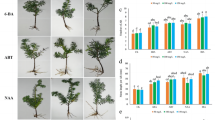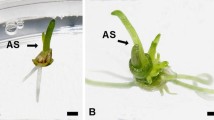Abstract
Adventitious rooting is essential for cutting propagation of pine wilt-resistant Pinus thunbergii. To examine a variety of adventitious rooting potentials among donor plants, cuttings were taken from 31 seedlings within a half-sib family. Rooting abilities of cuttings from each seedling ranged from 0 to 100%. When 11 ortets and 11 ramets (clonally propagated from each ortet) were used as donor plants, there was a positive correlation between rooting abilities of cuttings from ortets and ramets, suggesting that adventitious rooting is dependent on genetic factors in the donor plants. To promote adventitious rooting of cuttings by hormonal treatment, we examined the effect of soaking time in Oxyberon (19.7 mM indole-3-butyric acid (IBA) solution) on rooting. Ten minutes was the best soaking time for rooted cuttings to produce more adventitious roots without impairing normal growth. When cuttings were soaked in Ethrel diluent (69.2 μM ethephon) for 24 h before soaking in Oxyberon for 10 min, a significantly higher rooting ability was observed than those soaked in Oxyberon alone. Ethrel on its own barely affected rooting ability. The positive effect of the combinational treatment was confirmed in a similar experiment using authentic ethephon and IBA instead of Ethrel and Oxyberon. When cuttings were soaked in a mixture of ethephon and silver thiosulfate (STS), an ethylene action inhibitor, before IBA-soaking, the effect was partially diminished compared with combinational treatment without STS. These findings suggest that ethylene action caused by ethephon treatment promotes IBA-mediated adventitious rooting of P. thunbergii cuttings.







Similar content being viewed by others
References
Blakesley D (1994) Auxin metabolism and adventitious root initiation. In: Davis TD, Haissig BE (eds) Biology of adventitious root formation. Plenum Press, New York, pp 143–154
Browne RD, Davidson CG, Steeves TA, Dunstan DI (1997) Effects of ortet age on adventitious rooting of jack pine (Pinus banksiana) long-shoot cuttings. Can J For Res 27:91–96
Clark DG, Gubrium EK, Barrett JE, Nell TA, Klee HJ (1999) Root formation in ethylene-insensitive plants. Plant Physiol 121:53–59
De Klerk GJ (2002) Rooting of microcuttings: theory and practice. In Vitro Cell Dev Biol-Plant 38:415–422
De Klerk GJ, Van der Krieken W, De Jong JC (1999) The formation of adventitious roots: new concepts, new possibilities. In Vitro Cell. Devel Biol 35:189–199
Dougherty KA, LeBude AV, Goldfarb B, Blazich FA (2004) Rooting stem cuttings of loblolly pine using an aeroponic system. Proc SNA Res Conf 49th Ann Rep, pp 342–345
Ford Y-Y, Bonham EC, Cameron RWF, Blake PS, Judd HL, Harrison-Murray RS (2002) Adventitious rooting: examining the role of auxin in an easy- and a difficult-to-root plant. Plant Growth Regul 36:149–159
Foster GS (1990) Genetic control of rooting ability of stem cuttings from loblolly pine. Can J For Res 20:1361–1368
Fujimoto Y, Toda T, Nishimura K, Yamate H, Fuyuno S (1989) Breeding project on resistance to the pine-wood nematode. An outline of the research and the achievement of the project for 10 years—(in Japanese with English summary). Bull For Tree Inst 7:1–84
Goh CJ, Lakshmanan P, Lee CL, Loh CS, Tanaka M (1995) A simple and efficient method for clonal propagation of Casuarina sumatrana (de Vriese) L. Johnson. Plant Growth Regul 17:115–120
Goto S, Miyahara F (2000) Early growth and pinewood nematode-resistance of open-pollinated family of a nematode-resistant clone “Tanabe(t)-54” (in Japanese). Trans 53rd Ann Meet Kyushu Branch Jpn For Soc, pp 69–70
Greenwood MS, Weir RJ (1994) Genetic variation in rooting ability of loblolly pine cuttings: effects of auxin and family on rooting by hypocotyl cuttings. Tree Physiol 15:41–45
Greenwood MS, Cui X, Xu F (2001) Response to auxin changes during maturation-related loss of adventitious rooting competence in loblolly pine (Pinus taeda) stem cuttings. Physiol Plant 111:373–380
Gutierrez L, Bussell JD, Pacurar DI, Schwambach J, Pacurar M, Bellini C (2009) Phenotypic plasticity of adventitious rooting in Arabidopsis is controlled by complex regulation of AUXIN RESPONSE FACTOR transcripts and microRNA abundance. Plant Cell 21:3119–3132
Hartmann HT, Kester DE, Davis FT (1990) Plant propagation: principles and practices. Prentice Hall, New Jersey, pp 246–247
Henrique A, Campinhos EN, Ono EO, de Pinho SZ (2006) Effect of plant growth regulators in the rooting of Pinus cuttings. Braz Arch Biol Tech 49:189–196
Ichimura K, Goto R (2002) Extension of vase life of cut Narcissus tazetta var. chinensis flowers by combined treatment with STS and gibberellin A3. J Jpn Soc Hort Sci 71:226–230
Koukourikou-Petridou MA (1998) Etiolation of stock plants affects adventitious root formation and hormone content of pea stem cuttings. Plant Growth Regul 25:17–21
Kozlowski TT, Pallardy SG (1997) Growth control in woody plants. Academic Press, San Diego
Li H, Johnson P, Stepanova A, Alonso JM, Ecker JR (2004) Convergence of signaling pathways in the control of differential cell growth in Arabidopsis. Dev Cell 7:193–204
Li J, Dai X, Zhao Y (2006) A role for auxin response factor 19 in auxin and ethylene signaling in Arabidopsis. Plant Physiol 140:899–908
Liu J-H, Reid DM (1992) Auxin and ethylene-stimulated adventitious rooting in relation to tissue sensitivity to auxin and ethylene production in sunflower hypocotyls. J Exp Bot 43:1191–1198
Lorbiecke R, Sauter M (1999) Adventitious root growth and cell-cycle induction in deepwater rice. Plant Physiol 119:21–29
Ludwig-Müller J, Vertocnik A, Town CD (2005) Analysis of indole-3-butyric acid-induced adventitious root formation on Arabidopsis stem segments. J Exp Bot 56:2095–2105
Martinis DD, Mariani C (1999) Silencing gene expression of the ethylene-forming enzyme results in a reversible inhibition of ovule development in transgenic tobacco plants. Plant Cell 11:1061–1071
Mori Y, Miyahara F, Goto S (2004) The usefulness of rooted cuttings for producing nematode-resistant Japanese black pine plantlets (in Japanese with English summary). J Jpn For Soc 86:98–104
Mori Y, Miyahara F, Goto S (2006a) Improving the pine wilt disease resistance of cutting-propagated Japanese black pine plantlet populations by inoculating ortets with pinewood nematodes (in Japanese with English summary). J Jpn For Soc 88:197–201
Mori Y, Miyahara F, Goto S (2006b) The effect of rooted cutting propagation of non-damaged Japanese black pine through the inoculation test with pinewood nematode on nematode-resistant plant production. Pine wilt disease: a worldwide threat to forest ecosystems. International Symposium, Lisbon, pp 52–53
Okushima Y, Overvoorde PJ, Arima K, Alonso JM, Chan A, Chang C, Ecker JR, Hughes B, Lui A, Nguyen D, Onodera C, Quach H, Smith A, Yu G, Theologis A (2005) Functional genomic analysis of the AUXIN RESPONSE FACTOR gene family members in Arabidopsis thaliana: Unique and overlapping functions of ARF7 and ARF19. Plant Cell 17:444–463
Ota K (1980) Studies on root formation in cuttings (I). The effect of indoleacetic acid on root formation in Pinus thunbergii Parl. seedling cuttings (in Japanese with English summary). J Jpn For Soc 62:117–127
Pan R, Wang J, Tian X (2002) Influence of ethylene on adventitious root formation in mung bean hypocotyl cuttings. Plant Growth Regul 36:135–139
Sasaki M, Kuramoto N, Hiraoka Y, Okamura M, Fujisawa Y (2004) Effects of defoliation and disbudding on rooting ability of Japanese black pine cuttings (in Japanese with English summary). J Jpn For Soc 86:37–40
Stepanova AN, Hoyt JM, Hamilton AA, Alonso JM (2005) A link between ethylene and auxin uncovered by the characterization of two root-specific ethylene-insensitive mutants in Arabidopsis. Plant Cell 17:2230–2242
Swamy SL, Puri S, Singh AK (2002) Effect of auxins (IBA and NAA) and season on rooting of juvenile and mature hardwood cuttings of Robinia pseudoacacia and Grewia optiva. New For 23:143–157
Visser EJW, Cohen JD, Barendse GWM, Blom CWPM, Voesenek LACJ (1996) An ethylene-mediated increase in sensitivity to auxin induces adventitious root formation in flooded Rumex palustris Sm. Plant Physiol 112:1687–1692
Wagstaff C, Chanasut U, Harren FJM, Laarhoven L-J, Thomas B, Rogers HJ, Stead AD (2005) Ethylene and flower longevity in Alstroemeria: relationship between tepal senescence, abscission and ethylene biosynthesis. J Exp Bot 56:1007–1016
Zhao X-C, Qu X, Mathews DE, Schaller GE (2002) Effect of ethylene pathway mutations upon expression of the ethylene receptor ETR1 from Arabidopsis. Plant Physiol 130:1983–1991
Acknowledgments
The authors would like to thank Prof. S. Shiraishi for useful advice and suggestions on this study. This study was partly funded by the Agriculture, Forestry and Fisheries Research Council of Japan [Grant No. 1680].
Author information
Authors and Affiliations
Corresponding author
Rights and permissions
About this article
Cite this article
Mori, Y., Miyahara, F., Tsutsumi, Y. et al. Effects of combinational treatment with ethephon and indole-3-butyric acid on adventitious rooting of Pinus thunbergii cuttings. Plant Growth Regul 63, 271–278 (2011). https://doi.org/10.1007/s10725-010-9524-3
Received:
Accepted:
Published:
Issue Date:
DOI: https://doi.org/10.1007/s10725-010-9524-3




